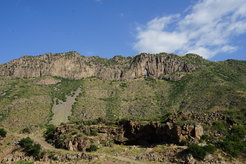Obsidian Study Shows Changing Land Use and Social Networks in Copper Age Armenia
A new research article published in Antiquity examines obsidian fragments from a newly discovered Copper Age site in Armenia. The finds reveals greater social connectivity across the landscape trough time.
The Chalcolithic Period, also known as the Copper Age, of the Southern Caucasus (5000–3500 BCE) was a period characterized by increased copper production alongside the continued use of lithic technology. Chronologically, the Chalcolithic is situated between the agricultural settlements of the Neolithic Period and the far-reaching Kura-Araxes material culture “package” of the Early Bronze Age. Despite the relevance of this time period for understanding the development of social complexity across the region, relatively little is known about the transformations during the Chalcolithic in this region.
In a pair of recent papers, a team of researchers from the Max Planck Institute of Geoanthropology, together with archaeologists from Yeghegnadzor Regional Museum, National Academy of Sciences of Armenia and Yale University, initiated a multidisciplinary exploration of a rockshelter site in Southern Armenia . Radiocarbon dating showed that the site was occupied by pastoralists for at least five centuries during this key period, from ∼4100–4000 cal BCE to ∼3600–3500 cal BCE.
Excavations at the Yeghegis-1 rockshelter, named after a nearby village, yielded tens of thousands of animal bones as well as numerous stone tools made of obsidian and earthenware sherds. Copper objects and slags (a waste product from smelting) were also recovered, along with artifacts manufactured from animal bones, including bone points and beads.

The researchers then turned their focus to the roughly 3,000 obsidian fragments, looking for evidence of two purported trends in the Southern Caucasus during the Chalcolithic Period: (1) the occupation of more varied high-altitude environments and (2) more expansive social networks.
Obsidian, which is only formed during volcanic eruptions, has its own unique assemblage of trace elements, giving it an identifiable fingerprint. Studying this chemical fingerprint allows researchers to match an individual piece of obsidian with known volcanic glass sources in the area, making it possible to trace movements of people as well as to probe possible trade or contact between different populations.

The results indicate that high-altitude living and expanding social networks both were dynamic processes. There was a greater balance in the use of the nearest pasturelands over time, presumably linked to risk management and/or resource sustainability. During later occupations of the site, artifacts from distant sources reveal more extensive connections. This increase in connectivity likely played a central role in the shifts in societal complexity that gave rise to a widely shared material culture throughout the Armenian Highlands around the start of the Early Bronze Age. In such a model, greater social connectivity becomes a key mechanism for, rather than a product of, the spread of cultural and/or technological innovations.
The researchers are continuing their work in the site, looking at other materials that could help further shed light on the lifeways of people that lived in the region during this important period in human history.

